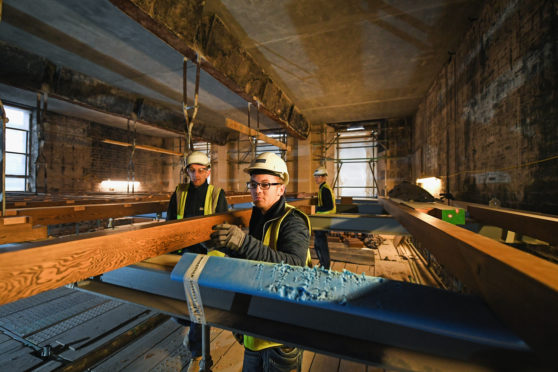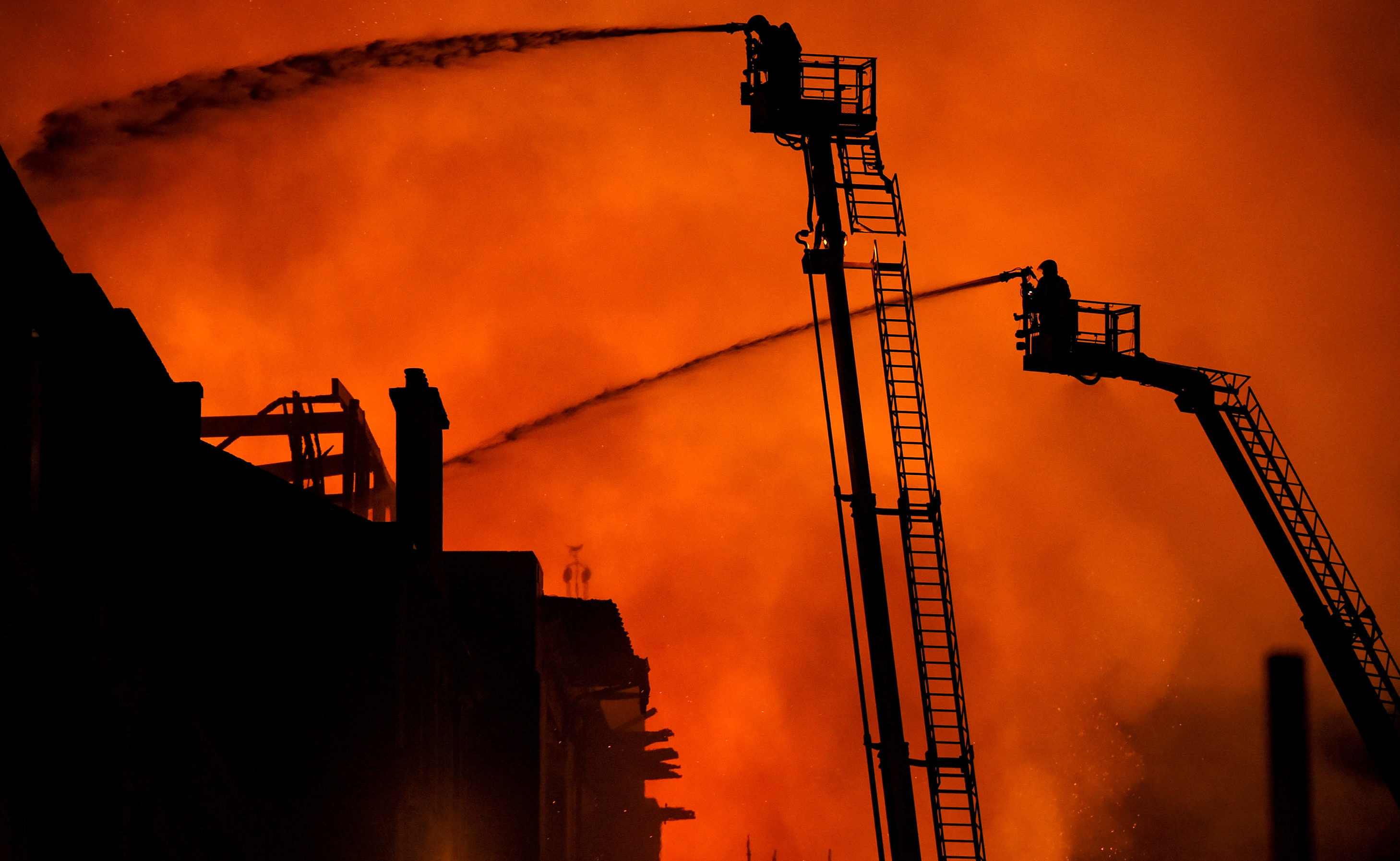
None of the £10 million of taxpayers’ money given to Glasgow School of Art after a devastating fire in 2014 was spent repairing the damage done by the blaze, we can reveal.
Insurance money paid for the restoration of the fire-damaged west wing of the iconic Mackintosh building, with millions of pounds given in public donations and government support going to refurbish the undamaged east wing and help fund a campus expansion plan announced two years after the blaze.
The art school is facing mounting pressure after a Sunday Post investigation last week exposed how insurance money repaired the fire damage despite supporters being urged to donate to “restore the Mack”.
A £5m payment from Westminster was given to the art school to help buy Stow College as part of the campus plans but another £5m meant to help repair the Mackintosh was never handed over because the art school could not convince the Treasury it was needed.
However, the Scottish Government did give the art school £5m, originally promised to rebuild the world-famous building in Glasgow designed by Charles Rennie Mackintosh.
First Minister Alex Salmond promised the money four days after the blaze in 2014 when the Scottish Government announced “funds raised to restore the Glasgow School of Art’s fire-damaged Mackintosh building to its former glory will be matched by the Scottish Government.”
However, on Friday, the Scottish Government said the money was spent refurbishing parts of the building untouched by the fire.
MSPs yesterday joined growing calls for a public inquiry to establish exactly how and where the money was raised and spent.
Claire Baker, Scottish Labour’s culture spokeswoman, is to write to the Government demanding answers over the donation.
She said: “I welcome the Sunday Post’s investigative work on this issue and I am writing to the Scottish Government to demand a full explanation of the money they committed.
“Whether intended or not, the clear impression given at the time was that £5m was for restoration costs, and the Scottish Government needs to explain why its support was diverted to other work and, given recent events, if it is still confident it was an appropriate use of public money.”
About 10% of the historic building was destroyed after a student’s art project ignited on May 23, 2014, including the famous wood-panelled library.
On May 27, 2014, Mr Salmond said: “The Mack is an extraordinary building. It is an architectural gem and the artistic heart of Glasgow. It can and will be restored, and everything that can be done must be done to deliver this.
“That is why the Scottish Government is committed to providing an appropriate level of financial support and we will, in the first instance, provide up to £5m match-funding for the GSA’s Mackintosh Building Fire Appeal.”
A press release added: “This funding will be in addition to any longer-term funding requirements for building recovery and restoration, and which will be supported by the Scottish Government and its agencies following full evaluation of insurance liability.”
Last week, the Sunday Post revealed how a global fundraising campaign, stressing the need to restore the fire-damaged Mackintosh building, was under scrutiny after the school collected around £50m from insurers.
At least £20m was donated to help the school but, two years after the fire, management announced a huge expansion plan aimed at increasing the number of students – many from overseas and paying up to £20,000 a year to study there – by 25%. The plans included the purchase of Stow College for £6m before an £8m refurbishment.
Managers and board members may now be asked back before MSPs to answer questions over the fundraising appeal, once the official fire investigation report is published next month.
And the escalating questions over the fundraising campaign in the aftermath of the 2014 fire have reinforced calls for a public inquiry with judicial powers.
Joan McAlpine, the culture committee’s convener, said the need for a full public inquiry, recommended by the committee after their hearings, was more pressing than ever. She said: “The Post’s investigation adds weight to our main recommendation that a full public enquiry with judicial powers should examine this whole affair.”
The Scottish Government money was paid to GSA in February 2018 via the Scottish Funding Council after proof was provided that it had raised £5m through its own efforts.
But a similar pledge of £5m from the UK Government has not yet been paid as it was conditional on the GSA proving that it needed the money for the rebuild.
On Friday, the Scottish Government said: “The 2014 fire did not extend to the whole of the Mackintosh building. The insurance payment covered the restoration of the damaged (west) wing.
“However, to ensure the long-term integrity of the building, the decision was taken to carry out refurbishment and restoration of the whole building. The insurance payment did not cover these additional costs.
“The additional costs were covered by the £5m provided by the Scottish Government and funding from the fundraising campaign.
“Glasgow School of Art spent the money in the way it was intended, given the need to extend the refurbishment beyond those parts of the building damaged in the fire and covered by insurance.
“The Scottish Government expects the highest standards of financial probity from all of the institutions it provides funding to. In particular, Higher Education Institutions must comply with the SFC’s terms and conditions of grant.”
A GSA spokeswoman said: “An appeal was set up in the immediate aftermath of the 2014 fire ‘enabling The Glasgow School of Art to recover from the consequences of the fire’ and in 2016 The Mackintosh Campus Appeal was launched to support a more holistic approach to the Mackintosh Building restoration and the recovery from the consequences of the fire, which had become clearer.
“This involved the restoration of the west wing – funded by insurance – and the upgrade and refurbishment of the east wing, funded by GSA’s own reserves and generous donations.”
“It is also important to note the purchase of the Stow Building was funded by a specific grant from the UK Treasury and is a replacement for buildings including the JD Kelly, Richmond and Tontine and not an expansion of the GSA campus.”
£100,000? A small sum in many ways
The director of Glasgow School of Art called £100,000 “a small sum in many ways” in an email to the Scottish Funding Council (SFC).
Professor Tom Inns wrote to the SFC in January 2016 to complain that the UK Government was withholding a £5 million donation for rebuilding the Mackintosh building. He said that, if the school had received the money earlier, it would have accrued up to £100,000 in interest, adding it was a “small sum in many ways but not inconsequential”.
He also sent an email to the SFC – an education-funding quango – saying he was “reframing” a fundraising drive for the Mackintosh building weeks after getting an insurance payout.
The Sunday Post can reveal details of the principle payout and how the school’s plans changed for the first time after obtaining 48 pages of emails between the school and public bodies.
Royal Sun Alliance, the main insurers, paid more than £45m to the GSA after negotiations were concluded, while accounts suggest another £4.3m was received from another insurer.
Professor Inns, who stood down suddenly from the GSA last year, wrote to the SFC to say they had received a “very fair and helpful settlement”.
He said the GSA was keen to expand its campus to deal with increasing student numbers, and buying the former Stow College building had been identified as a solution.
The purchase could be financed through a “portfolio of sources”.
By 2016, the GSA’s original plans to raise up to £35m to restore The Mack had morphed into a £80m plan to transform the campus, including the Stow purchase.
Professor Inns said: “GSA plans to make a public statement/relaunch its Mackintosh appeal towards the end of March 2016.
“This will slightly reframe exactly what the GSA needs external funding for.
“The Stow College development plans are integral to restoration of the Mackintosh building.”
We donated £6,500. It was a lot for us but we didn’t know about the insurance
A community arts organisation which donated £6,500 to the art school after the 2014 fire yesterday said it had no idea insurance money would rebuild the Mackintosh building.
The organisers of a Glasgow Girls exhibition in KIrkcudbright in 2014 handed over small cash donations made by visitors.
Joe Campbell, then-chairman of Kirkcudbright 2000, says they should have been told the money was not needed to rebuild the Mackintosh building.
He said: “There’s been a lack of transparency, obviously.
“No one was told the insurance company had covered the costs. I don’t know that anybody has deliberately led us up the garden path but I think they should have come back to those who donated and said this is not going to be used for the purpose you thought.
“Without question when we then asked the public to donate, we would have told them it was likely the insurance company was going to meet the bill.”
Mr Campbell said the donation from Kirkcudbright 2000 – half of the proceeds generated by the Glasgow Girls 1920-1960 exhibition – could have been used to fund projects in the town.
He added that the money was a significant sum as the group has struggled to raise funds and relied on well-wishers giving “a fiver or a tenner”.
He said: “We were not big donors because we didn’t have an awful lot.
“But we gave the money that we did in all good faith towards the reincarnation of what was there before, which was really so important to Scottish art.
“We had no idea that the costs of the rebuild were going to be covered by the insurance policy.
“It was in all good faith because it was such an integral part of Scottish art and particularly in Kirkcudbright which is an artists’ town.
“All the well-known painters who lived in Kirkcudbright at the turn of the century – and ever since – were trained at the Glasgow School of Art, so it was very dear to our hearts.”

Enjoy the convenience of having The Sunday Post delivered as a digital ePaper straight to your smartphone, tablet or computer.
Subscribe for only £5.49 a month and enjoy all the benefits of the printed paper as a digital replica.
Subscribe © (Jeff J Mitchell/Getty Images
© (Jeff J Mitchell/Getty Images